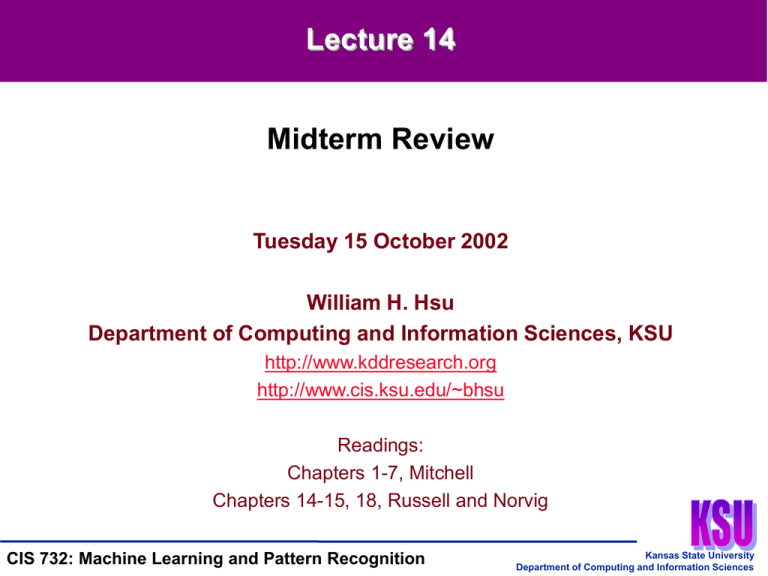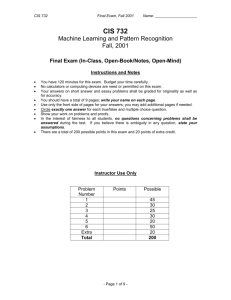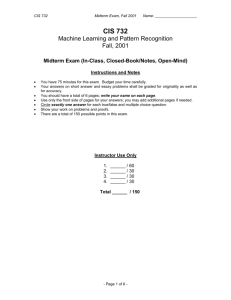CIS732-Lecture-14-20011009 - Kansas State University
advertisement

Lecture 14
Midterm Review
Tuesday 15 October 2002
William H. Hsu
Department of Computing and Information Sciences, KSU
http://www.kddresearch.org
http://www.cis.ksu.edu/~bhsu
Readings:
Chapters 1-7, Mitchell
Chapters 14-15, 18, Russell and Norvig
CIS 732: Machine Learning and Pattern Recognition
Kansas State University
Department of Computing and Information Sciences
Lecture 0:
A Brief Overview of Machine Learning
•
Overview: Topics, Applications, Motivation
•
Learning = Improving with Experience at Some Task
– Improve over task T,
– with respect to performance measure P,
– based on experience E.
•
Brief Tour of Machine Learning
– A case study
– A taxonomy of learning
– Intelligent systems engineering: specification of learning problems
•
Issues in Machine Learning
– Design choices
– The performance element: intelligent systems
•
Some Applications of Learning
– Database mining, reasoning (inference/decision support), acting
– Industrial usage of intelligent systems
CIS 732: Machine Learning and Pattern Recognition
Kansas State University
Department of Computing and Information Sciences
Lecture 1:
Concept Learning and Version Spaces
•
Concept Learning as Search through H
– Hypothesis space H as a state space
– Learning: finding the correct hypothesis
•
General-to-Specific Ordering over H
– Partially-ordered set: Less-Specific-Than (More-General-Than) relation
– Upper and lower bounds in H
•
Version Space Candidate Elimination Algorithm
– S and G boundaries characterize learner’s uncertainty
– Version space can be used to make predictions over unseen cases
•
Learner Can Generate Useful Queries
•
Next Lecture: When and Why Are Inductive Leaps Possible?
CIS 732: Machine Learning and Pattern Recognition
Kansas State University
Department of Computing and Information Sciences
Lecture 2:
Inductive Bias and PAC Learning
•
Inductive Leaps Possible Only if Learner Is Biased
– Futility of learning without bias
– Strength of inductive bias: proportional to restrictions on hypotheses
•
Modeling Inductive Learners with Equivalent Deductive Systems
– Representing inductive learning as theorem proving
– Equivalent learning and inference problems
•
Syntactic Restrictions
– Example: m-of-n concept
•
Views of Learning and Strategies
– Removing uncertainty (“data compression”)
– Role of knowledge
•
Introduction to Computational Learning Theory (COLT)
– Things COLT attempts to measure
– Probably-Approximately-Correct (PAC) learning framework
•
Next: Occam’s Razor, VC Dimension, and Error Bounds
CIS 732: Machine Learning and Pattern Recognition
Kansas State University
Department of Computing and Information Sciences
Lecture 3:
PAC, VC-Dimension, and Mistake Bounds
•
COLT: Framework Analyzing Learning Environments
– Sample complexity of C (what is m?)
– Computational complexity of L
– Required expressive power of H
– Error and confidence bounds (PAC: 0 < < 1/2, 0 < < 1/2)
•
What PAC Prescribes
– Whether to try to learn C with a known H
– Whether to try to reformulate H (apply change of representation)
•
Vapnik-Chervonenkis (VC) Dimension
– A formal measure of the complexity of H (besides | H |)
– Based on X and a worst-case labeling game
•
Mistake Bounds
– How many could L incur?
– Another way to measure the cost of learning
•
Next: Decision Trees
CIS 732: Machine Learning and Pattern Recognition
Kansas State University
Department of Computing and Information Sciences
Lecture 4:
Decision Trees
•
Decision Trees (DTs)
– Can be boolean (c(x) {+, -}) or range over multiple classes
– When to use DT-based models
•
Generic Algorithm Build-DT: Top Down Induction
– Calculating best attribute upon which to split
– Recursive partitioning
•
Entropy and Information Gain
– Goal: to measure uncertainty removed by splitting on a candidate attribute A
• Calculating information gain (change in entropy)
• Using information gain in construction of tree
– ID3 Build-DT using Gain(•)
•
ID3 as Hypothesis Space Search (in State Space of Decision Trees)
•
Heuristic Search and Inductive Bias
•
Data Mining using MLC++ (Machine Learning Library in C++)
•
Next: More Biases (Occam’s Razor); Managing DT Induction
CIS 732: Machine Learning and Pattern Recognition
Kansas State University
Department of Computing and Information Sciences
Lecture 5:
DTs, Occam’s Razor, and Overfitting
•
Occam’s Razor and Decision Trees
– Preference biases versus language biases
– Two issues regarding Occam algorithms
• Why prefer smaller trees?
(less chance of “coincidence”)
• Is Occam’s Razor well defined?
(yes, under certain assumptions)
– MDL principle and Occam’s Razor: more to come
•
Overfitting
– Problem: fitting training data too closely
• General definition of overfitting
• Why it happens
– Overfitting prevention, avoidance, and recovery techniques
•
Other Ways to Make Decision Tree Induction More Robust
•
Next: Perceptrons, Neural Nets (Multi-Layer Perceptrons), Winnow
CIS 732: Machine Learning and Pattern Recognition
Kansas State University
Department of Computing and Information Sciences
Lecture 6:
Perceptrons and Winnow
•
Neural Networks: Parallel, Distributed Processing Systems
– Biological and artificial (ANN) types
– Perceptron (LTU, LTG): model neuron
•
Single-Layer Networks
– Variety of update rules
• Multiplicative (Hebbian, Winnow), additive (gradient: Perceptron, Delta Rule)
• Batch versus incremental mode
– Various convergence and efficiency conditions
– Other ways to learn linear functions
• Linear programming (general-purpose)
• Probabilistic classifiers (some assumptions)
•
Advantages and Disadvantages
– “Disadvantage” (tradeoff): simple and restrictive
– “Advantage”: perform well on many realistic problems (e.g., some text learning)
•
Next: Multi-Layer Perceptrons, Backpropagation, ANN Applications
CIS 732: Machine Learning and Pattern Recognition
Kansas State University
Department of Computing and Information Sciences
Lecture 7:
MLPs and Backpropagation
•
Multi-Layer ANNs
– Focused on feedforward MLPs
– Backpropagation of error: distributes penalty (loss) function throughout network
– Gradient learning: takes derivative of error surface with respect to weights
• Error is based on difference between desired output (t) and actual output (o)
• Actual output (o) is based on activation function
• Must take partial derivative of choose one that is easy to differentiate
• Two definitions: sigmoid (aka logistic) and hyperbolic tangent (tanh)
•
Overfitting in ANNs
– Prevention: attribute subset selection
– Avoidance: cross-validation, weight decay
•
ANN Applications: Face Recognition, Text-to-Speech
•
Open Problems
•
Recurrent ANNs: Can Express Temporal Depth (Non-Markovity)
•
Next: Statistical Foundations and Evaluation, Bayesian Learning Intro
CIS 732: Machine Learning and Pattern Recognition
Kansas State University
Department of Computing and Information Sciences
Lecture 8:
Statistical Evaluation of Hypotheses
•
Statistical Evaluation Methods for Learning: Three Questions
– Generalization quality
• How well does observed accuracy estimate generalization accuracy?
• Estimation bias and variance
• Confidence intervals
– Comparing generalization quality
• How certain are we that h1 is better than h2?
• Confidence intervals for paired tests
– Learning and statistical evaluation
• What is the best way to make the most of limited data?
• k-fold CV
•
Tradeoffs: Bias versus Variance
•
Next: Sections 6.1-6.5, Mitchell (Bayes’s Theorem; ML; MAP)
CIS 732: Machine Learning and Pattern Recognition
Kansas State University
Department of Computing and Information Sciences
Lecture 9:
Bayes’s Theorem, MAP, MLE
•
Introduction to Bayesian Learning
– Framework: using probabilistic criteria to search H
– Probability foundations
• Definitions: subjectivist, objectivist; Bayesian, frequentist, logicist
• Kolmogorov axioms
•
Bayes’s Theorem
– Definition of conditional (posterior) probability
– Product rule
•
Maximum A Posteriori (MAP) and Maximum Likelihood (ML) Hypotheses
– Bayes’s Rule and MAP
– Uniform priors: allow use of MLE to generate MAP hypotheses
– Relation to version spaces, candidate elimination
•
Next: 6.6-6.10, Mitchell; Chapter 14-15, Russell and Norvig; Roth
– More Bayesian learning: MDL, BOC, Gibbs, Simple (Naïve) Bayes
– Learning over text
CIS 732: Machine Learning and Pattern Recognition
Kansas State University
Department of Computing and Information Sciences
Lecture 10:
Bayesian Classfiers: MDL, BOC, and Gibbs
•
Minimum Description Length (MDL) Revisited
– Bayesian Information Criterion (BIC): justification for Occam’s Razor
•
Bayes Optimal Classifier (BOC)
– Using BOC as a “gold standard”
•
Gibbs Classifier
– Ratio bound
•
Simple (Naïve) Bayes
– Rationale for assumption; pitfalls
•
Practical Inference using MDL, BOC, Gibbs, Naïve Bayes
– MCMC methods (Gibbs sampling)
– Glossary: http://www.media.mit.edu/~tpminka/statlearn/glossary/glossary.html
– To learn more: http://bulky.aecom.yu.edu/users/kknuth/bse.html
•
Next: Sections 6.9-6.10, Mitchell
– More on simple (naïve) Bayes
– Application to learning over text
CIS 732: Machine Learning and Pattern Recognition
Kansas State University
Department of Computing and Information Sciences
Lecture 11:
Simple (Naïve) Bayes and Learning over Text
•
More on Simple Bayes, aka Naïve Bayes
– More examples
– Classification: choosing between two classes; general case
– Robust estimation of probabilities: SQ
•
Learning in Natural Language Processing (NLP)
– Learning over text: problem definitions
– Statistical Queries (SQ) / Linear Statistical Queries (LSQ) framework
• Oracle
• Algorithms: search for h using only (L)SQs
– Bayesian approaches to NLP
• Issues: word sense disambiguation, part-of-speech tagging
• Applications: spelling; reading/posting news; web search, IR, digital libraries
•
Next: Section 6.11, Mitchell; Pearl and Verma
– Read: Charniak tutorial, “Bayesian Networks without Tears”
– Skim: Chapter 15, Russell and Norvig; Heckerman slides
CIS 732: Machine Learning and Pattern Recognition
Kansas State University
Department of Computing and Information Sciences
Lecture 12:
Introduction to Bayesian Networks
•
Graphical Models of Probability
– Bayesian networks: introduction
• Definition and basic principles
• Conditional independence (causal Markovity) assumptions, tradeoffs
– Inference and learning using Bayesian networks
• Acquiring and applying CPTs
• Searching the space of trees: max likelihood
• Examples: Sprinkler, Cancer, Forest-Fire, generic tree learning
•
CPT Learning: Gradient Algorithm Train-BN
•
Structure Learning in Trees: MWST Algorithm Learn-Tree-Structure
•
Reasoning under Uncertainty: Applications and Augmented Models
•
Some Material From: http://robotics.Stanford.EDU/~koller
•
Next: Read Heckerman Tutorial
CIS 732: Machine Learning and Pattern Recognition
Kansas State University
Department of Computing and Information Sciences
Lecture 13:
Learning Bayesian Networks from Data
•
Bayesian Networks: Quick Review on Learning, Inference
– Learning, eliciting, applying CPTs
– In-class exercise: Hugin demo; CPT elicitation, application
– Learning BBN structure: constraint-based versus score-based approaches
– K2, other scores and search algorithms
•
Causal Modeling and Discovery: Learning Cause from Observations
•
Incomplete Data: Learning and Inference (Expectation-Maximization)
•
Tutorials on Bayesian Networks
– Breese and Koller (AAAI ‘97, BBN intro): http://robotics.Stanford.EDU/~koller
– Friedman and Goldszmidt (AAAI ‘98, Learning BBNs from Data):
http://robotics.Stanford.EDU/people/nir/tutorial/
– Heckerman (various UAI/IJCAI/ICML 1996-1999, Learning BBNs from Data):
http://www.research.microsoft.com/~heckerman
•
Next Week: BBNs Concluded; Post-Midterm (Thu 11 Oct 2001) Review
•
After Midterm: More EM, Clustering, Exploratory Data Analysis
CIS 732: Machine Learning and Pattern Recognition
Kansas State University
Department of Computing and Information Sciences
Meta-Summary
•
Machine Learning Formalisms
– Theory of computation: PAC, mistake bounds
– Statistical, probabilistic: PAC, confidence intervals
•
Machine Learning Techniques
– Models: version space, decision tree, perceptron, winnow, ANN, BBN
– Algorithms: candidate elimination, ID3, backprop, MLE, Naïve Bayes, K2, EM
•
Midterm Study Guide
– Know
• Definitions (terminology)
• How to solve problems from Homework 1 (problem set)
• How algorithms in Homework 2 (machine problem) work
– Practice
• Sample exam problems (handout)
• Example runs of algorithms in Mitchell, lecture notes
– Don’t panic!
CIS 732: Machine Learning and Pattern Recognition
Kansas State University
Department of Computing and Information Sciences





